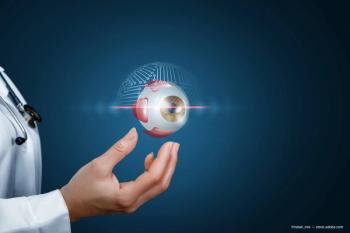
ASCRS 2023: 10-year follow-up for collagen cross-linking and keratoconus ectasia
Steven Greenstein, MD, sat down with David Hutton, Managing Editor, Ophthalmology Times®, to discuss his presentation about the 10-year follow-up for collagen cross-linking and keratoconus ectasia.
Steven Greenstein, MD, sat down with David Hutton, Managing Editor, Ophthalmology Times®, to discuss his presentation about the 10-year follow-up for collagen cross-linking and keratoconus ectasia.
Video transcript
Editor’s note: This transcript has been edited for clarity.
David Hutton:
I'm David Hutton of Ophthalmology Times. ASCRS recently held its annual meeting in San Diego. I'm joined by Dr. Steven Greenstein. At the conference, he made a presentation titled "10-year Followup for Collagen Cross-linking and Keratoconus Ectasia: Comparison of Outcomes with Subsequent Topography-altering Surgery." Thank you so much for joining us today. Tell us about your presentation.
Steven Greenstein, MD:
Thanks, David. So this year, we presented on a different aspect of the 10-year outcomes after cross-linking. We specifically looked at the difference between eyes that had cross-linking and had a subsequent topography-guided procedure, whether that be a corneal inlay or a excimer procedure vs the patients who only had cross-linking 10 years before and was there any difference in stability? In general, we looked at stability with regards to vision and topography. We had defined progression as a loss of 2 lines of best-corrected vision, a steepening of the maximum keratometry of 2 diopters or more, or a 95% Confidence Interval progression on the ABCD Belen display on the pentacam, and we focused in on the A and B portions, the anterior and the posterior curvature. So in the total cohort of patients, which included 29 eyes that we looked at all treated in the original pivotal cross-linking trials, which led to the original FDA approval of cross-linking.
We looked at both the total cohort, we looked at patients' eyes with keratoconus and eyes separately with ectasia after LASIK. What we found was that in the entire cohort, about 86% of patients who were treated remain stable with regards to their vision. Actually, 100% of the keratoconic patients were stable and about 71% of the ectasia patients. When we looked at topography, both for the Belen ABC display at maximum keratometry, we found that about 75% of patients remained stable. Overall, about 86% remain stable in the keratoconus group and two thirds, about 66%, remain stable in the ectasia group.
When we compared the eyes that had subsequent surgery with the eyes that only had cross-linking, statistically we did not find any difference between the 2 groups. Although overall, when we compared the keratoconus group with the ectasia group, we found that there was clearly more stability in the keratoconus eyes then in the eyes with ectasia.
So, the take-home message overall is that we must continue to counsel our patients that even after cross-linking they must continue to be monitored for progression because of course cross-linking is repeatable and a much better alternative to needing further surgery on their eyes, such as corneal transplant, and particularly in our patients who have ectasia after LASIK. We really must counsel them that about a third of them required retreatment over a 10-year period and they need very close monitoring even after the cross-linking is done.
Newsletter
Don’t miss out—get Ophthalmology Times updates on the latest clinical advancements and expert interviews, straight to your inbox.
















































.png)


